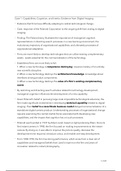Case 1: Capabilities, Cognition, and Inertia: Evidence from Digital Imaging
- Evidence that firms have difficulty adapting to radical technological change.
- Case: response of the Polaroid Corporation to the ongoing shift from analog to digital
imaging.
- Finding: The Polaroid story illustrates the importance of managerial cognitive
representations in directing search processes in a new learning environment, the
evolutionary trajectory of organisational capabilities, and ultimately processes of
organisational adaptation.
- Firms are more likely to develop technologies that can utilise existing complementary
assets - assets essential for the commercialisation of the technology.
- Established firms are more likely to fail:
1. When a new technology is competence destroying: requires mastery of an entirely
new scientific discipline.
2. When a new technology destroys the architectural knowledge: knowledge about
interfaces among product components.
3. When a new technology destroys the value of a firm's existing complementary
assets
- By restricting and directing search activities related to technology development,
managerial cognition influences the development of a new capability.
- Given Polaroid's belief in pursuing large scale impossible technological advances, the
firm made significant investments in developing technical capability related to digital
imaging. Their belief in a razor/blade business model delayed commercialisation of a
standalone digital camera product. Understanding processes of organizational change
requires examining the central inertial forces associated with developing new
capabilities, and the impact that cognition has on such processes.
- Polaroid was founded in 1937 by Edwin Land, based on light-polarising filters. Since its
first instant camera in 1948, the firm focused on making improvements to the instant
camera. By doing so, it was able to improve the picture quality, decrease the
development time required, introduce colour, and enable one-step development.
- From 1948-1978, the firm has strong performance, which arose from a clear set of
capabilities and managerial beliefs from Land's imprint on the firm and years of
innovation related to instant photography.
1 of 28
,- Capabilities and Beliefs in 1980
• Polaroid's capabilities centred around its dominant position in instant photography.
Land himself has 500 patents. The patent position was so strong that it sued Kodak in
1976.
• Developments of Polaroid:
• Manufacturing was another strength. In the 1960s the first brought manufacturing in-
house. Both a camera manufacturing plant and a colour negative plant were built. The
evolution of these plants over time resulted in two distinct manufacturing capabilities:
1. Precision camera assembly
2. Thin film coating
• Strong distribution through mass market retailers such as K-Mart and WalMart.
Innovative use of channels contributed to Polaroid's success - i.e. it avoided direct
competition with traditional cameras sold in specialised camera stores.
• Autocratic leadership of Land.
• Polaroid was a technology-driven, not market-driven, firm. Here, Polaroid believed
that success came through long-term, large-scale research projects.
- The evaluation of capabilities and beliefs at Polaroid:
2 of 28
, - The 1980 capabilities and beliefs has an influence on Polaroid's approach to digital
imaging. The digital imaging search efforts were led by a new CEO, Bill McCune (who
took over Land in mid 1980s).
• Began with substantial investments in digital imaging technologies: electronic
imaging group (microelectronics laboratory/R&D) with technological areas for
exploration (microelectronics, IC design, advanced optical design, image processing,
software design, PC board design, surface mount assembly, CAD/CAM/FEA design,
and fiber optics)
• 90% of employees in the microelectronics lab were newly hired, because it covered
new scientific ground for the firm
• Efforts in the group were guided by a desire to develop an instant digital camera/print
(i.e. PIF/Printer In the Field). This PIF built on Polaroid's prior capabilities and beliefs:
leveraged manufacturing capabilities, consistent with belief in razor/blade model, and
consistent with belief that consumers value instant physical print.
• Efforts in group were also guided by desire to develop a medical system called
Helios, which used high-energy laser to expose a dry film material. Like PIF, it was built
on Polaroid's prior capabilities and beliefs: leveraged chemical knowledge base,
manufacturing consistent with thin film coating, business model was razor/blade, and
large-scale invention belief.
• Also a series of image recorders were developed and sold during this period.
- Problems with 1980-1989 capabilities and beliefs:
• Three areas of capability that the firm did not invest in:
1. Low-cost electronics manufacturing capability
2. Rapid product development capability
3. New marketing and sales capability
• To compete in the hardware arena a new business model was necessary: low-cost
electronics manufacturing capability and rapid product development capability (two
areas in which Polaroid was weak).
1. Low-cost electronics manufacturing capability was fundamental to increasing the
typically smaller margins in the hardware business.
2. Fast product development capability was necessary to permit the timely introduction
of innovative products in a market where product life cycles were measured in months,
as opposed to the years Polaroid was accustomed to for its instant imaging products.
• The firm never invested in developing sales/marketing capability specific to digital
imaging.
3 of 28





